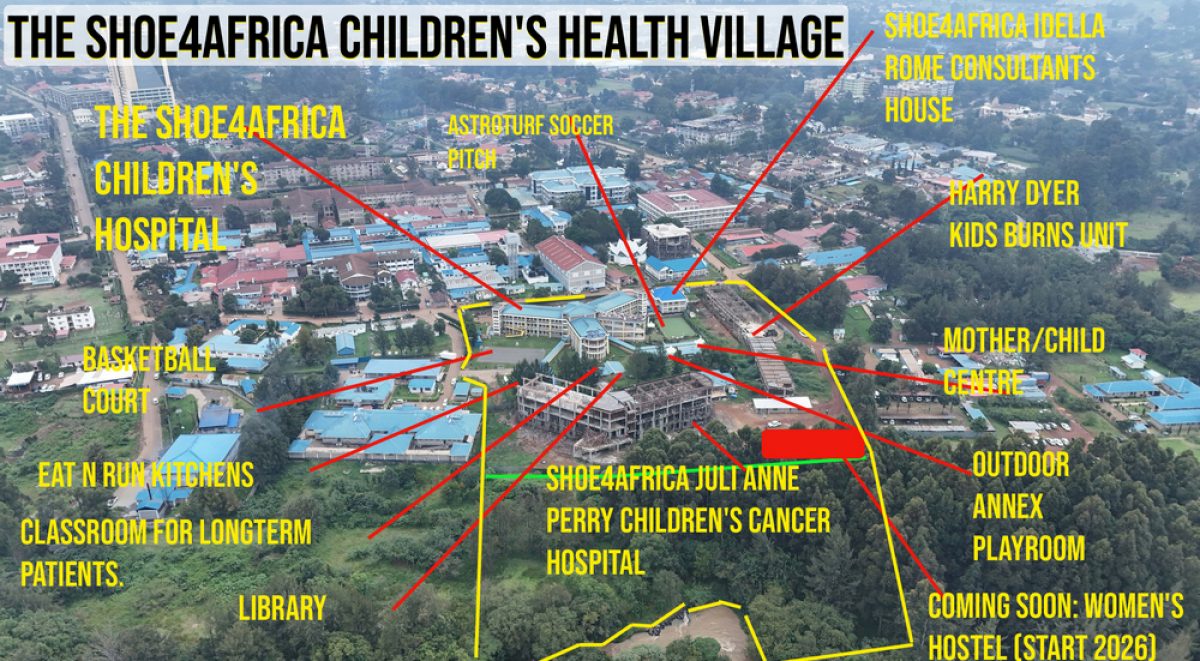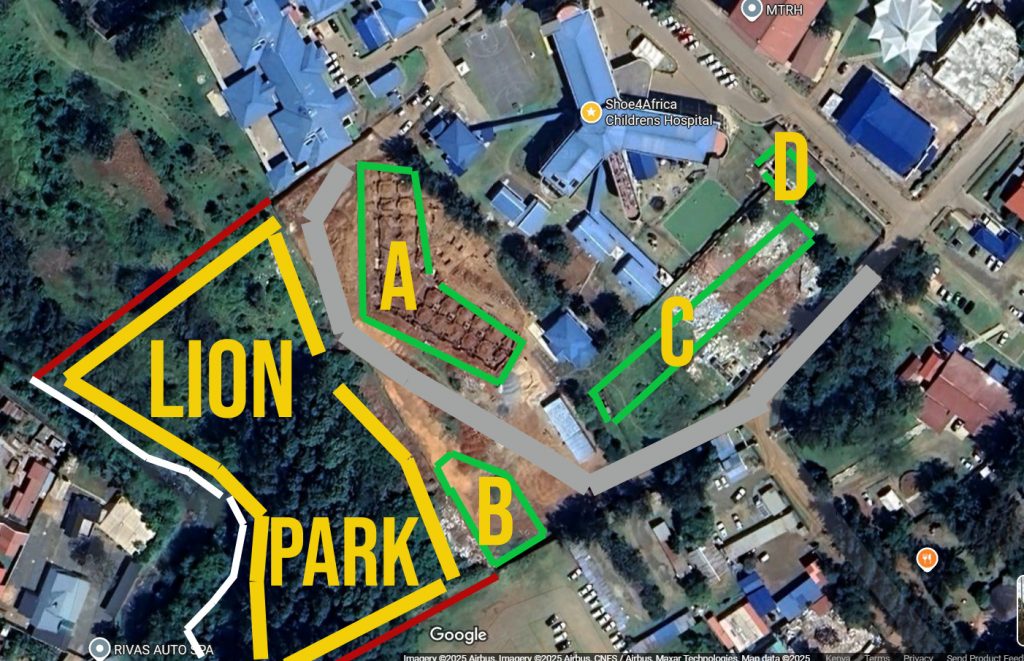
For the wooded area, in front of the cancer hospital, we are now planning a park for kids. Working title ‘Lion Park’ an adventure wonderland for sick kids suffering from cancer.
The Vision
Imagine a magical, Disney-like outdoor space where:
- Children suffering from cancer can play freely on swings, slides, climbing frames, and see-saws with an underground area of rubber mats for safety in a semi-wooded safe area. They will be close to the other hospital patients, but be totally separated from unwanted germs/diseases that could be fatal to their compromised immune systems.
- Parents, patients, and caregivers can rest in shaded thatch huts—designed as safe, peaceful palliative care spaces—listening to the gentle gurgle of the Sosiani River.
- Families find respite from long treatment days in a place designed for joy, connection, and healing.
- A health walk jogging loop around the perimeter
Why It Matters
The journey of pediatric cancer treatment is exhausting, emotionally draining, and often isolating—especially in sub-Saharan Africa where support facilities are rare. By creating a safe, beautiful recreational area adjacent to the hospital, The Park addresses several of LCIF’s recommended grant priorities:
- Enhancing healthcare environments by creating outdoor spaces for waiting and recovery.
- Supporting children’s emotional health through play and recreation.
- Providing palliative care support in a comforting, natural setting.
The Design
- Playground Zone: Colorful, inclusive equipment for children of all ages and abilities.
- Side walls: ensuring privacy from the outside world
- Rest & Reflection Areas: Thatched huts offering a bit of seclusion in the park.
- Safety Infrastructure: The secure wall along the side perimeter and a chain-link fence with concrete posts in front of the Sosiani River.
- Landscaping: Lush greenery, flowering plants, and shaded pathways.
- Solar lit: Even in the evenings, patients, parents, and staff will be using the park.
- 24/7 CCTV security: Linked tot he hospital’s security firm.
1. Inclusive & Accessible Play Structures
Look for equipment that welcomes children of all abilities—especially children with medical needs or disabilities. Key features include wheelchair-accessible ramps, inclusive swings, and sensory play panels at ground level to promote cooperative play Soft Playinqilaplay.com.
2. Sensory-Rich Equipment
Sensory play enhances cognitive and emotional development and helps children relax in a clinical setting. Consider tactile panels, musical elements (like sound boards), visually stimulating components, and proprioceptive or vestibular equipment (e.g., movement-based structures) Soft Playinqilaplay.com.
3. Therapeutic Soft Play & Custom Indoor Solutions
Soft Play specializes in healthcare settings—using antimicrobial, easy-to-clean materials that exceed safety standards. They offer modular designs, branded themes, and ADA-compliant accessibility healthhighroad.com.
4. Healing Outdoor Themes
Outdoor playgrounds infused with nature and sensory elements—as done by Landscape Structures—are proven to reduce stress and support healing. Designs like rooftop gardens or coastal-themed play zones (sea creatures, nature motifs) help connect children with a sense of calm and wonder healthhighroad.com.
5. Safe & Age-Appropriate Surfacing
Safety surfaces are essential. Options like poured-in-place rubber, engineered wood fiber, or rubber tiles cushion falls and support mobility devices WikipediaPMC. Spaces should also be divided by age group—ideas like toddler-friendly zones with low platforms and older kids’ areas with climbers or obstacle challenges are essential for safety and engagement inqilaplay.comUPMC Children’s Hospital of Pittsburgh.
6. Quiet & Restorative Spaces
Hospital environments can overwhelm. Quiet zones—shaded retreats, sensory nooks, and enclosed bubbles—offer emotional respite and make the playground inviting for neurodiverse children Soft PlaySpecial Education Needs and Disabilities.
Inspiration in Action
- A children’s hospital in Minneapolis created an IV-friendly slide and themed this playground after local wildlife—including elephant trunks and manta ray climbers—making it both accessible and magical .
- Missouri’s therapy center features a wildlife-themed play setup with sensory mist features and a giraffe sensory wall—bridging therapy and play in a visually engaging way Landscape Structures Inc.
Summary: Best-in-Class Playground Features
| Feature | Description |
|---|---|
| Inclusive Structures | Ramps, sensory panels, adaptive swings for all abilities |
| Sensory Elements | Touch, sound, balance, and visual stimulation panels |
| Soft Play Modules | Safe, customizable themed components for indoors |
| Nature-Inspired Design | Gardens, animal motifs, healing outdoor landscapes |
| Safe Surfacing | ADA-compliant, shock absorbent surfaces |
| Age-Zoned Layout | Separate areas for toddlers and older children |
| Quiet Zones | Calm spaces for rest and sensory regulation |
Final Thoughts
A hospital playground should be more than just fun—it should be therapeutic, inclusive, safe, and healing. With thoughtful design and playful creativity—like the examples above—you can create a space where every child feels welcomed, strengthened, and inspired.

Budget:
West Wall 170 meters, East Wall 211 meters, and river front 170 meters – approx 560 meters
Concrete 10 ft posts @ 1500ksh,
Chain link 18 meters length at 8 ft high @ 10,800ksh
Barbed wire, three lines of 560 meters
Kayapur, manure, watering.
Concrete paving slabs
Wood chip trail
18 x 300 Watt solar floodlights, mounted on 25 foot poles
Trampoline (on the round level), Swings,
Fountain, with an area for kids to play under
Musical Chimes
Outdoor gym
Outdoor Play Center
Petting dog (kennel), Aquarium area.


